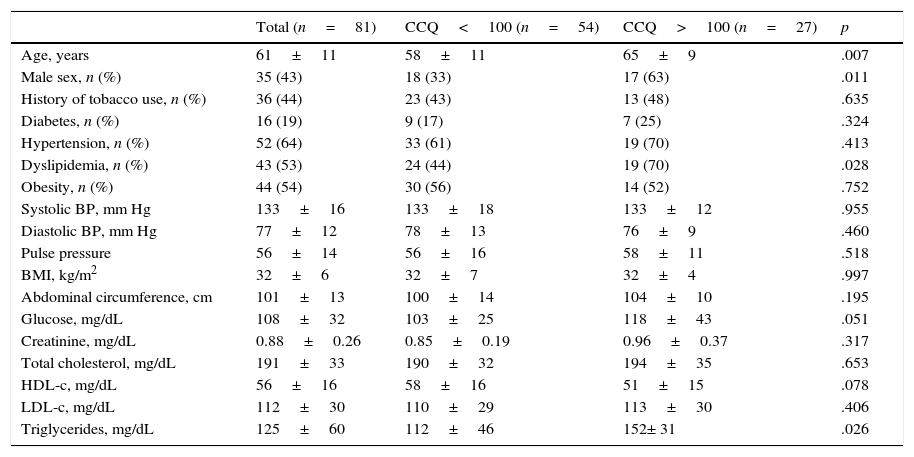The pulse wave velocity (PWV) in the great arteries is an indicator of vascular risk. Our objective was to identify the PWV index between the arms and legs that best correlates with the coronary calcium quantification (CCQ) and to compare it with other methods.
Material and methodsEight-one patients without vascular disease underwent the following measurements: CCQ; carotid intima-media thickness (IMT); carotid-femoral PWV (cfPWV), using COMPLIOR; and PWV in the arms and legs, with our own device (abiPWV, ankle brachial index PWV).
ResultsThe difference in PWVs between the leg and arm (l-a PWV) measured with abiPWV was the index that best correlated with CCQ (r=0.401, p<.001). The correlation between IMT and CCQ and between CF-PWV and CCQ were r=0.366, p=.001; and r=0.385, p=.001, respectively. For a CCQ score higher than 100 as a marker of significant coronary arteriosclerosis, the areas under the curve for l-a PWV, IMT and cfPWV were 0.721 (p=.002), 0.758 (p<.001) and 0.636 (p=.058), respectively.
ConclusionsFor patients without vascular disease, the l-a PWV measured with abiPWV appears to be the index that best correlates with the CCQ. This association is comparable to that between IMT and CCQ and between cfPWV and CCQ. The abiPWV is an easy-to-use device that can help improve vascular risk stratification.
La medida de la velocidad de onda de pulso (VOP) en las grandes arterias es un indicador de riesgo vascular. Nuestro objetivo fue identificar el índice de VOP entre brazos y piernas que mejor se correlaciona con la cuantificación del calcio coronario (CCC) y compararlo con otros métodos.
Material y métodosA 81 pacientes sin enfermedad vascular, a los que se les había determinado la CCC, se les midió el grosor íntima-media carotídeo (GIM), la VOP carótido-femoral (VOP cf) con COMPLIOR y la VOP en brazos y piernas con un dispositivo propio (VOPITB: VOP índice tobillo brazo).
ResultadosLa VOP de pierna menos brazo (VOP P-B) determinado con VOPITB fue el índice mejor correlacionado con la CCC (r=0,401, p<0,001). Las correlaciones del GIM y VOP cf con la CCC fueron: r=0,366, p=0,001 y r=0,385, p=0,001, respectivamente. Con referencia a una puntuación de la CCC mayor de 100 como marcador de arterosclerosis coronaria significativa, las áreas bajo la curva fueron para VOP P-B de 0,721 (p=0,002), GIM: 0,758 (p<0,001) y VOP cf: 0,636 (p=0,058).
ConclusionesEn pacientes sin enfermedad vascular la VOP P-B medida con VOPITB parece ser el índice que mejor correlaciona con la CCC. Esta asociación es comparable con la que mantienen el GIM y la VOP cf con la CCC. VOPITB es un dispositivo fácil de manejar que puede contribuir a mejorar la estratificación del riesgo vascular.
Article
Diríjase desde aquí a la web de la >>>FESEMI<<< e inicie sesión mediante el formulario que se encuentra en la barra superior, pulsando sobre el candado.

Una vez autentificado, en la misma web de FESEMI, en el menú superior, elija la opción deseada.

>>>FESEMI<<<










